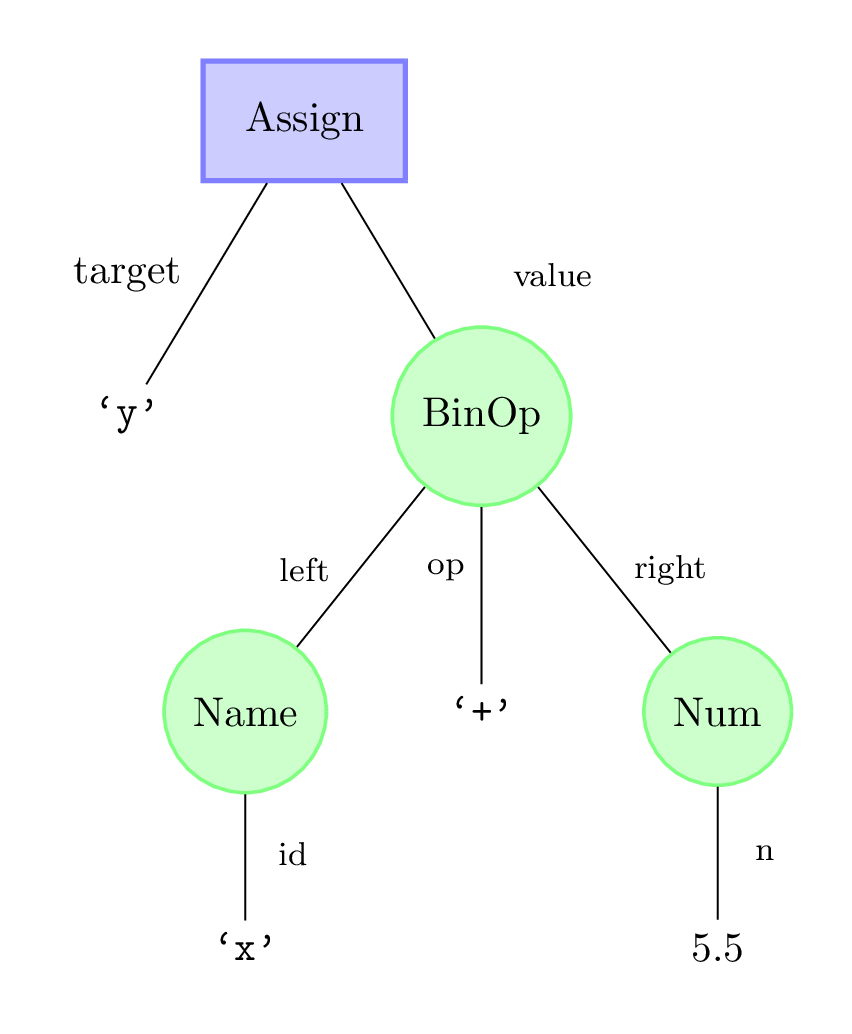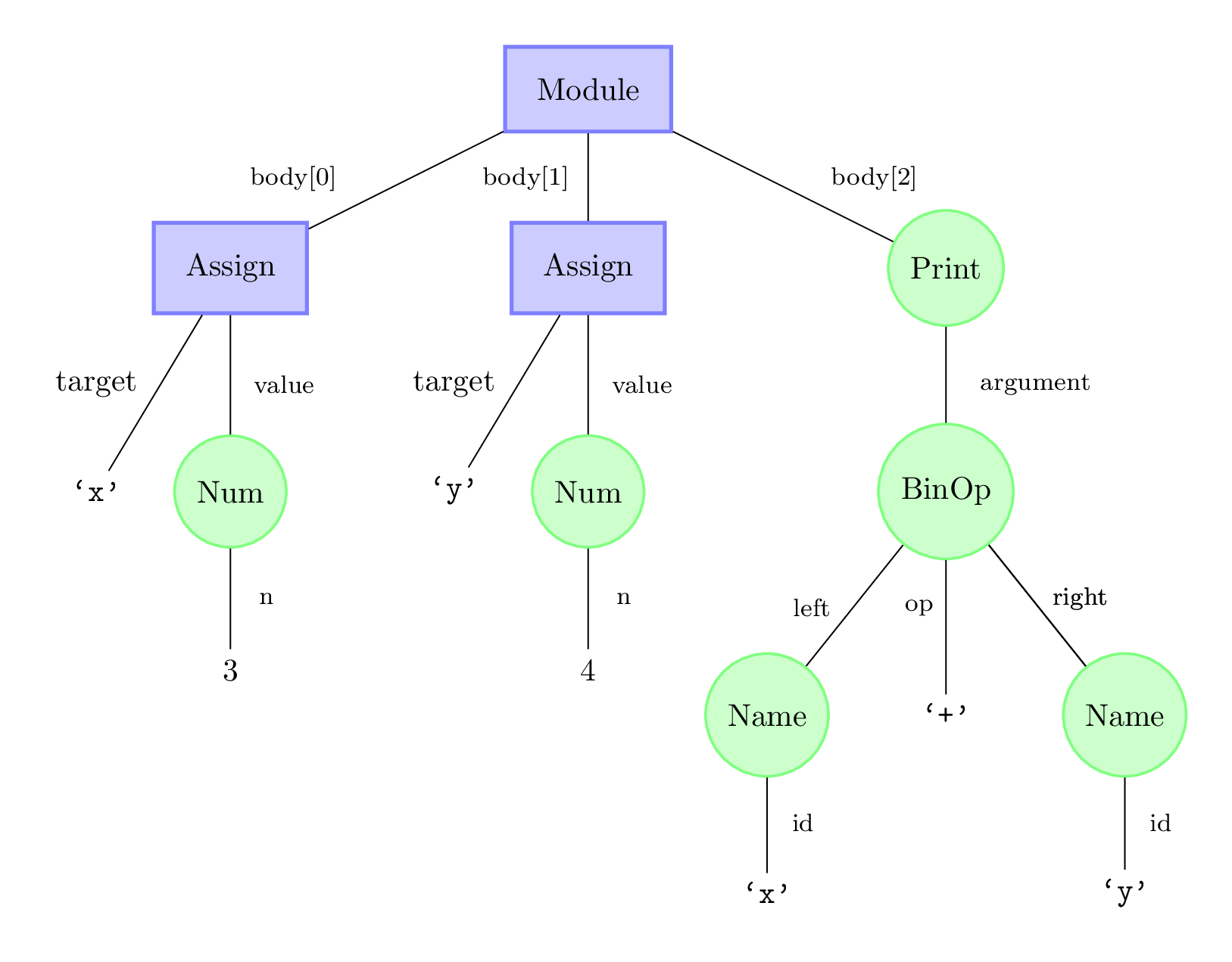In the previous two sections, we looked at how to represent Python expressions using abstract syntax trees. However, expressions are only one subset of possible Python code, and so in this section we’ll turn our attention to representing and evaluating Python statements as well.
The Statement
abstract class
As we learned all the way back in 1.6 Storing Data in Variables, all expressions are statements, but not all statements are expressions. When we evaluate an expression, we expect to get a value returned. But when we evaluate a statement, we often do not get back a value, but instead some other effect, like recording a variable assignment, manipulating control flow or returning from a function.
So how we’ll represent this in code is by creating a new abstract
class Statement, that is a parent of Expr.
class Statement:
"""An abstract class representing a Python statement.
We think of a Python statement as being a more general piece of code than a
single expression, and that can have some kind of "effect".
"""
def evaluate(self, env: dict[str, Any]) -> Optional[Any]:
"""Evaluate this statement with the given environment.
This should have the same effect as evaluating the statement by the
real Python interpreter.
Note that the return type here is Optional[Any]: evaluating a statement
could produce a value (this is true for all expressions), but it might
only have a *side effect* like mutating `env` or printing something.
"""
raise NotImplementedError
class Expr(Statement):
"""An abstract class representing a Python expression.
We've now modified this class to be a subclass of Statement.
"""You might wonder, why bother with an Expr class at all?
As we’ll see in this section, Statement may have many
different subclasses beyond Expr, representing
non-expression statements like assignment statements. Keeping
Expr is useful for distinguishing between expression types
and non-expression types. For example, a BinOp’s
left and right attributes must be of type
Expr, not
Statement. Consider, for example, the invalid Python
code (x = 3) + (y = 5). Assignment statements can’t be
added together!
Assign: an
assignment statement
Let’s start by resolving an issue we encountered at the end of the
previous section: how do we actually build up the variable environment?
To do this, we’ll need to represent assignment statements as a new data
type that we’ll call Assign:
class Assign(Statement):
"""An assignment statement (with a single target).
Instance Attributes:
- target: the variable name on the left-hand side of the equals sign
- value: the expression on the right-hand side of the equals sign
"""
target: str
value: Expr
def __init__(self, target: str, value: Expr) -> None:
"""Initialize a new Assign node."""
self.target = target
self.value = value
def evaluate(self, env: dict[str, Any]) -> ...:
"""Evaluate this statement with the given environment.
"""For example, here’s how we could represent the statement
y = x + 5.5:

Assign('y', BinOp(Name('x'), '+', Num(5.5)))Let’s consider how to implement Assign.evaluate.
Intuitively, we know what needs to happen: we need to evaluate its
value, and then assign that value to the variable
target. But what does “assigning” a variable actually mean
in this context? This is exactly the purpose of env: it
stores the current variable bindings! So to assign a variable, we need
to mutate
env. Note the return type below: since this method only
performs a mutation operation, the return type is
None.
class Assign:
def evaluate(self, env: dict[str, Any]) -> None:
"""Evaluate this statement with the given environment.
"""
env[self.target] = self.value.evaluate(env)Print:
displaying text to the user
The second Statement subclass we’ll consider is
Print, which represents a call to the function
print. In earlier versions of Python, print was
actually a keyword (like def or return), and
so really did require its own statement type. However, in our current
version of Python, print is a function, and so this
statement type is really a special case of a more general “function
call” expression. We’ll use these to actually display values to
the user.
class Print(Statement):
"""A statement representing a call to the `print` function.
Instance Attributes:
- argument: The argument expression to the `print` function.
"""
argument: Expr
def __init__(self, argument: Expr) -> None:
"""Initialize a new Print node."""
self.argument = argument
def evaluate(self, env: dict[str, Any]) -> None:
"""Evaluate this statement.
This evaluates the argument of the print call, and then actually
prints it. Note that it doesn't return anything, since `print` doesn't
return anything.
"""
print(self.argument.evaluate(env))Module: a sequence
of statements
Now that we have two different Statement subclasses,
let’s talk about putting statements together. For this purpose we’ll
define a new class called Module, which represents a full
Python program, consisting of a sequence of statements.
class Module:
"""A class representing a full Python program.
Instance Attributes:
- body: A sequence of statements.
"""
body: list[Statement]
def __init__(self, body: list[Statement]) -> None:
"""Initialize a new module with the given body."""
self.body = bodyFor example, consider the following short Python program:
x = 3
y = 4
print(x + y)We can represent this as follows:
Module([
Assign('x', Num(3)),
Assign('y', Num(4)),
Print(BinOp(Name('x'), '+', Name('y')))
])
Note that Module itself is not a subclass of
Statement, as a Module can’t be nested
recursively within other Modules. However, we can think of
a Module as being the root of a complete abstract
syntax tree, as visualized by the above diagram.
Evaluating modules
To evaluate a module, we do two things: first, initialize an empty dictionary to represent the environment (starting with no variable bindings), and then iterate over each statement the module body and evaluate it.
class Module:
def evaluate(self) -> None:
"""Evaluate this statement with the given environment.
"""
env = {}
for statement in self.body:
statement.evaluate(env)Let’s revisit our above example:
x = 3
y = 4
print(x + y)
# Or, as an abstract syntax tree:
Module([
Assign('x', Num(3)),
Assign('y', Num(4)),
Print(BinOp(Name('x'), '+', Name('y')))
])In this case, the module body has three statements. The first two
Assign statements mutate env when we call
their evaluate methods, so that env becomes
the dictionary {'x': 3, 'y': 4}. Then in the final
Print statement, this env is passed
recursively through the calls to evaluate, so that the
vales of x and y can be looked up.
Control flow statements
Finally, we’ll briefly mention that we can represent compound
statements (i.e., statements that consist of other statements) using the
same idea as a Module. For example, here is one way we
could define a restricted form of an if statement that has just two
branches, an if and else
branch: Try combining this with the Expr classes
you defined in the prep exercises for this chapter!
class If(Statement):
"""An if statement.
This is a statement of the form:
if <test>:
<body>
else:
<orelse>
Instance Attributes:
- test: The condition expression of this if statement.
- body: A sequence of statements to evaluate if the condition is True.
- orelse: A sequence of statements to evaluate if the condition is False.
(This would be empty in the case that there is no `else` block.)
"""
test: Expr
body: list[Statement]
orelse: list[Statement]And similarly, we can represent a for loop over a range of numbers:
class ForRange(Statement):
"""A for loop that loops over a range of numbers.
for <target> in range(<start>, <stop>):
<body>
Instance Attributes:
- target: The loop variable.
- start: The start for the range (inclusive).
- stop: The end of the range (this is *exclusive*, so <stop> is not included
in the loop).
- body: The statements to execute in the loop body.
"""
target: str
start: Expr
stop: Expr
body: list[Statement]We encourage you to try implementing these two classes as exercises!